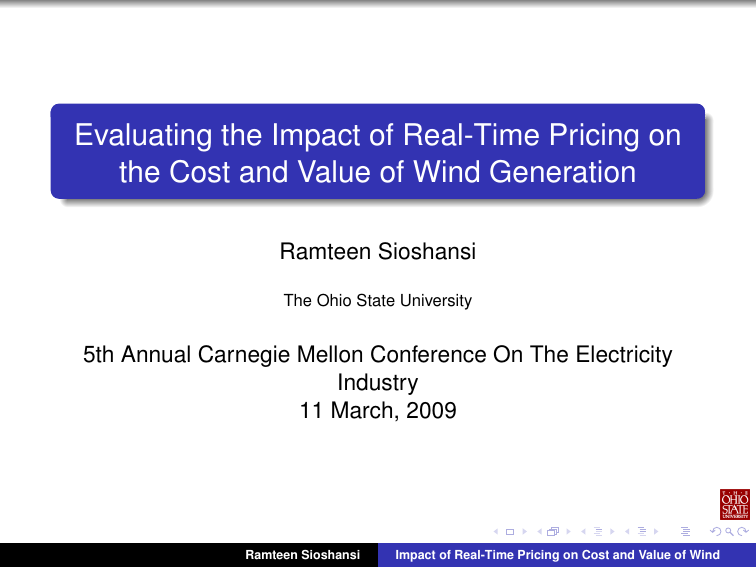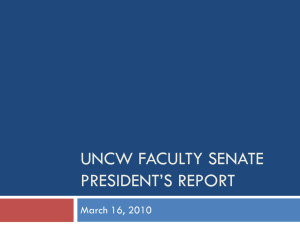Evaluating the Impact of Real-Time Pricing on Ramteen Sioshansi
advertisement

Evaluating the Impact of Real-Time Pricing on the Cost and Value of Wind Generation Ramteen Sioshansi The Ohio State University 5th Annual Carnegie Mellon Conference On The Electricity Industry 11 March, 2009 Ramteen Sioshansi Impact of Real-Time Pricing on Cost and Value of Wind Problem Background Wind generation and resource forecasting errors introduce operational challenges and costs to power systems: Incorrect wind resource forecasts day-ahead can cause suboptimal unit commitments These can also result in costly redispatch and deployment of ancillary services in real-time Very poor forecasts can require load to be shed if insufficient capacity is available in real-time Many studies focus on the impacts of wind uncertainty on day-ahead and real-time dispatch, and suggest this timeframe is a major cost of wind integration Fabbri et. al. (2005) show wind forecast error costs can be up to 10% of wind revenues DeMeo et. al. (2005) and Smith et. al. (2007) survey wind integration studies and show costs of up to $5/MWh of wind CEC (2007) and CAISO (2007) have both estimated need for more ancillary services and real-time redispatch to integrate wind into California’s power system Ramteen Sioshansi Impact of Real-Time Pricing on Cost and Value of Wind Introducing Demand Response Real-time pricing (RTP) can help alleviate these costs of wind by using price signals to get demand to follow the supply of wind: If wind forecasts turn out to be too high, the high real-time price of energy and ancillary service deployments will reduce real-time demand for energy This demand reduction can also prevent the need for load curtailments if forecast errors are very high RTP can also increase the social value of wind Sioshansi and Short (2009) have shown RTP can reduce the need to curtail wind due to conventional generator or power system constraints RTP has been shown to increase social welfare compared to fixed retail rates These two effects can work in concert with one another, giving superadditive surplus gains We show that RTP can noticeably reduce these costs and increase the value of wind Ramteen Sioshansi Impact of Real-Time Pricing on Cost and Value of Wind Modeling Approach Overview We use a unit commitment model to represent day-ahead (DA) operations and a dispatch model for real-time (RT) dispatch DA model uses forecasts of wind availability RT model uses actual wind availability and fixed commitments from DA model (except quick-start units, which are allowed to be started) to serve load We simulate operations in ERCOT for an entire year To model a high wind scenario, we use system data (loads, conventional generator set, generation costs) from 2005, but include all wind plants slated to be installed by 2011 Amounts to over 18 GW of wind, or 18% of total capacity Each day is modeled in sequence, with starting state of generators taken from previous day and ending state determined by next day’s expected operations Cost of system operations is compared to a scenario with perfect foresight of wind resource availability Ramteen Sioshansi Impact of Real-Time Pricing on Cost and Value of Wind Modeling Approach Wind Generation Model Actual hourly wind availability is taken from mesoscale-model data compiled by 3TIER, based on geographic location of wind plants being modeled DA forecast of wind availability is simulated as being the actual wind availability plus a forecast error Empirical analysis of actual and forecasted wind data done by AWS Truewind and CAISO (2007) shows forecast error fits an unbiased second-order autocorrelated truncated normal distribution (TND) We simulate forecast errors from a TND, assuming an autocorrelation coefficient of 0.60 and a range of variances between 0.0049 and 0.0121 (which is consistent with CAISO’s estimates) Ramteen Sioshansi Impact of Real-Time Pricing on Cost and Value of Wind Modeling Approach Other Data Sources Generation costs (consisting of startup, spinning no-load, and stepped marginal generation) computed based upon heat rate and fuel cost, VO&M, and emission price data from Platts Energy and Global Energy Decisions (GED) Generator constraint data also from GED Hourly load data from ERCOT Models without RTP formulated to serve fixed load at minimum cost Models with RTP formulated to maximize social welfare Demand functions approximated as non-increasing step function with 100 steps Assume demand exhibits own-price elasticity only, use a range of elasticities between −0.10 and −0.30 Functions calibrated to go through point defined by actual historical load and retail electricity rate Ramteen Sioshansi Impact of Real-Time Pricing on Cost and Value of Wind Wind Forecast Error Cost With Fixed Loads Table summarizes annual increase in system operation costs with DA wind availability forecast errors and fixed loads, showing costs increase with higher forecast error variance (i.e. less accurate DA forecasts) Forecast Error Variance 0.0049 0.0064 0.0081 0.0100 0.0121 Forecast Error Cost ($/MWh Wind Generation) 0.868 1.109 1.385 1.744 2.172 Ramteen Sioshansi Impact of Real-Time Pricing on Cost and Value of Wind Wind Forecast Error Cost With Fixed Loads—Lost Load One cost not included in previous table is value of lost load With fixed loads high wind forecast errors can cause loss of load if there’s insufficient capacity available in real-time Figure shows forecast error cost with lost load included, as a function of VOLL These costs can be substantial with high forecast error variance Ramteen Sioshansi Impact of Real-Time Pricing on Cost and Value of Wind Wind Forecast Error Cost With RTP When comparing cost of wind forecast errors with RTP, it is more appropriate to measure social welfare losses Comparing cost alone does not capture consumer surplus losses from curtailing load in response to reduced wind availability When computing surplus losses without RTP, we assume there is a demand function l(p), which is not expressed due to fixed retail rate. Lost load is valued using willingness to pay assuming random curtailment Ramteen Sioshansi Impact of Real-Time Pricing on Cost and Value of Wind Wind Forecast Error Cost With RTP: Elasticity −0.1 Table summarizes social welfare losses ($/MWh of wind generation) with DA wind availability forecast errors if actual demand elasticity is −0.1, showing RTP can reduce losses by up to 80% Forecast Error Variance 0.0049 0.0064 0.0081 0.0100 0.0121 Ramteen Sioshansi Without RTP 0.889 1.209 1.682 2.355 3.361 With RTP 0.310 0.380 0.477 0.539 0.661 Impact of Real-Time Pricing on Cost and Value of Wind Wind Forecast Error Cost With RTP: Elasticity −0.2 Table summarizes social welfare losses ($/MWh of wind generation) with DA wind availability forecast errors if actual demand elasticity is −0.2, showing RTP can reduce losses by up to 89% Forecast Error Variance 0.0049 0.0064 0.0081 0.0100 0.0121 Ramteen Sioshansi Without RTP 0.879 1.162 1.543 2.068 2.804 With RTP 0.133 0.166 0.212 0.252 0.302 Impact of Real-Time Pricing on Cost and Value of Wind Wind Forecast Error Cost With RTP: Elasticity −0.3 Table summarizes social welfare losses ($/MWh of wind generation) with DA wind availability forecast errors if actual demand elasticity is −0.3, showing RTP can reduce losses by up to 93% Forecast Error Variance 0.0049 0.0064 0.0081 0.0100 0.0121 Ramteen Sioshansi Without RTP 0.875 1.146 1.497 1.973 2.618 With RTP 0.081 0.116 0.134 0.152 0.171 Impact of Real-Time Pricing on Cost and Value of Wind Wind Forecast Error Cost With RTP—Lost Load Another benefit of RTP is that there is no lost load When wind forecasts are too high, the high cost of replacement energy reduces demand A secondary benefit of RTP is that the “least valuable” load is shed when wind availability is less than forecast Without RTP, load curtailment may rely on inefficient means of rationing supply We compare consumer surplus losses (per MWh of curtailed load) from “random” load curtailment as opposed to curtailing consumers with the lowest willingness to pay Forecast Error Variance 0.0049 0.0064 0.0081 0.0100 0.0121 Ramteen Sioshansi Demand Elasticity −0.1 −0.2 −0.3 995.59 497.80 331.86 1038.13 519.07 346.04 979.91 489.95 326.64 1006.80 503.40 335.60 976.31 488.15 325.44 Impact of Real-Time Pricing on Cost and Value of Wind Value of Wind with RTP RTP has been shown to have multiple welfare benefits Borenstein (2002) and Borenstein and Holland (2005) are two papers showing RTP increases short-run social welfare from electricity use We’ve shown RTP increases use of wind and decreases social surplus losses from wind forecast errors Wind provides a costless source of energy in the short-run, which will increase social welfare We use our model to see if these two effects together result in superadditive surplus gains We examine four different scenarios: 1 2 3 4 no RTP, no wind generators; no RTP, wind generators; RTP, no wind generators; and RTP, wind generators. If we let σi denote social welfare under scenario i, then if σ4 − σ1 > σ3 + σ2 − 2σ1 , there are superadditive welfare gains from introducing both wind and RTP Ramteen Sioshansi Impact of Real-Time Pricing on Cost and Value of Wind Value of Wind with RTP Example Table below demonstrates these welfare gains with a forecast error variance of 0.0049. Values are annual social surplus gains ($ million) Adding wind generation Adding RTP Sum of surplus gains Adding wind and RTP Demand Elasticity −0.1 −0.2 −0.3 2,658 2,658 2,658 190 355 489 2,848 3,013 3,147 2,924 3,131 3,298 Comparing last two rows shows surplus gains from introducing wind and RTP together Ramteen Sioshansi Impact of Real-Time Pricing on Cost and Value of Wind Value of Wind with RTP Summary Table summarizes social welfare gains from adding wind and RTP, as a percentage of sum of welfare gains from σ4 −σ1 introducing each independently (i.e. σ3 +σ ) 2 −2σ1 Forecast Error Variance 0.0049 0.0064 0.0081 0.0100 0.0121 Ramteen Sioshansi Demand Elasticity −0.1 −0.2 −0.3 2.7 3.9 4.8 2.9 4.3 5.1 3.2 4.6 5.5 3.7 5.1 6.0 4.2 5.7 6.6 Impact of Real-Time Pricing on Cost and Value of Wind Conclusions Day-ahead uncertainty in and forecast errors of wind resource availability can lead to suboptimal unit commitments, costly real-time system dispatch, and even lost load As expected, these costs rise as forecasts become more inaccurate (variance rises) Introducing demand response/RTP allows the load to more closely follow supply of wind generation, and reduces wind integration costs The cost reduction becomes more pronounced with more elastic demand RTP also eliminates lost load events, which would otherwise occur with fixed loads The combination of RTP and wind result in superadditive surplus gains compared to introducing these individually Ramteen Sioshansi Impact of Real-Time Pricing on Cost and Value of Wind


